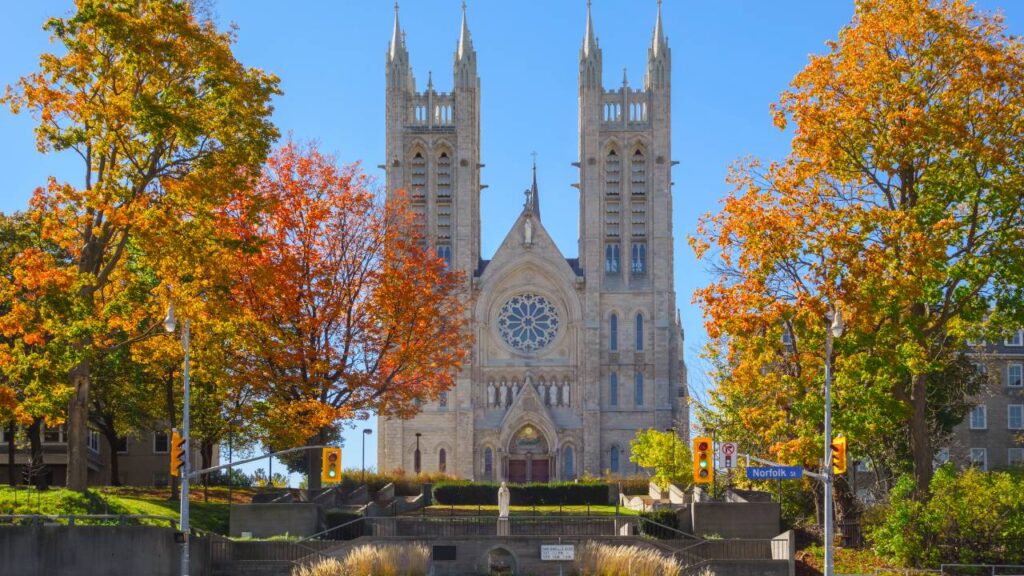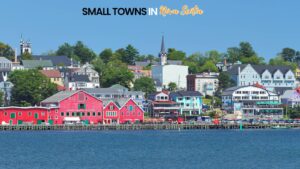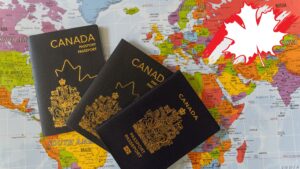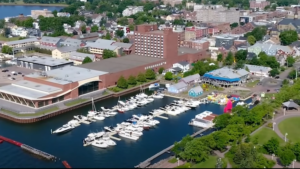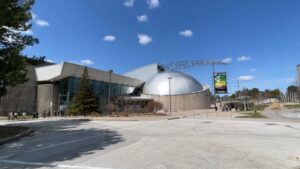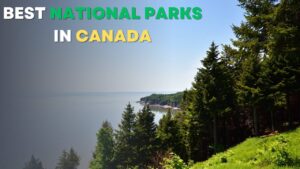Canada is a country of striking contrasts — from the icy beauty of the Yukon in January to the fiery maple foliage in October. A winter sports enthusiast, a nature lover, a culture seeker, or just someone looking for a scenic escape, Canada has something exceptional to offer every month of the year.
Here’s a complete, month-by-month guide to help you decide when is the best time to visit Canada based on weather, events, and travel experiences.
January – A True Winter Wonderland
In January, Canada is blanketed in snow, transforming into a majestic winter paradise that enchants visitors with its serene, frosty landscapes. This is the peak season for snow sports and holiday charm, with cities and towns shimmering under frosty lights and festive decorations. The deep winter atmosphere invites travelers to cozy up in charming mountain lodges or visit lively urban winter activities.
Top Experiences in January:
1. Skiing & Snowboarding:
Head to world-renowned resorts like Whistler Blackcomb in British Columbia, Lake Louise in Alberta, and Mont Tremblant in Quebec. These destinations offer impeccably groomed trails, powder-rich backcountry options, ski schools for beginners, and an energetic après-ski culture complete with cozy lodges, fire pits, and local brews. For those new to snow sports, professional instructors ensure a safe and enjoyable experience, while seasoned enthusiasts will relish the varied terrain and untouched powder.
2. Ice Skating on Natural Rinks:
Ottawa’s Rideau Canal becomes the world’s largest natural skating rink, drawing locals and tourists alike. Gliding along the 7.8 km stretch, surrounded by snowy cityscapes, visitors can enjoy the lively ambiance, stop for BeaverTails (a Canadian pastry), sip hot chocolate, and participate in family-friendly activities and live music events held along the canal. This experience is a quintessential part of Canadian winter culture.
3. Winter Festivals:
The Quebec Winter Carnival is the crown jewel of January festivities. With its giant snow sculptures, colorful night parades, and the famous Bonhomme mascot, the carnival offers a glimpse into the joyful spirit of French-Canadian culture. Activities like snow rafting, outdoor concerts, traditional food tastings, and cultural workshops make it a must-visit for travelers eager to dive into local traditions.
Weather Overview
Expect sub-zero temperatures across most regions. Cities like Winnipeg or Edmonton can drop below -20°C, while coastal areas like Vancouver remain somewhat milder but still chilly. Snowfall is frequent and heavy, creating a magical winter backdrop that’s perfect for photography and festive enjoyment.
January is the ideal month for travelers dreaming of a snow-laden holiday with dazzling winter landscapes, cozy mountain villages, and world-class snow adventures. It’s also a quieter travel period after the holiday rush, so those seeking tranquility and authentic winter charm will find it here.
February – Festivals and Romance Amid Snow
The deep freeze continues, but February turns up the cultural and romantic atmosphere. Snowy landscapes become the setting for cozy retreats and vibrant festivals that celebrate Canadian winter’s beauty and community spirit.
Top Experiences in February:
1. Ice Hotel Stay in Quebec:
A night at the Hôtel de Glace is a bucket-list experience. Built entirely from snow and ice, this ephemeral hotel features themed suites with artistic carvings, an ice chapel perfect for winter weddings, and an ice bar serving cocktails in frozen glasses. It’s both a romantic and adventurous getaway, perfect for couples or anyone seeking a truly unique accommodation experience.
2. SnowDays in Banff:
The SnowDays Festival brings Banff to life with towering snow sculptures and creative ice carvings displayed across the town. Visitors can enjoy ice carving competitions, fat biking events on snowy trails, outdoor skating rinks, and warm beverage trails while surrounded by the stunning Rocky Mountains’ majestic scenery. The festival also includes live music and family activities, making it a lively winter event.
3. Romantic Getaways:
Valentine’s Day is celebrated in full Canadian style with cabin escapes in Ontario’s cottage country, spa resorts in British Columbia, and northern light tours in Yukon. Many resorts offer romance packages including sleigh rides, private hot tubs, candlelit dinners, and spa treatments. It’s a perfect time to disconnect from everyday stresses and indulge in wintertime romance.
Weather Overview
Most of Canada remains in deep winter, with colder temperatures than January in some interior regions. Snow covers much of the land, while coastal cities like Vancouver remain rainy but relatively mild, offering a break from harsh cold for those sensitive to extreme winter conditions.
February is for travelers seeking snow-covered charm, romantic escapes, and lively cultural festivals amid stunning winter scenery. The combination of outdoor adventure and cozy, intimate experiences makes this month highly attractive for couples and winter enthusiasts alike.
March – The Great Thaw Begins
March signals the slow retreat of winter and the tantalizing first hints of spring. Southern Canada begins to defrost, creating a unique blend of snowy adventure and spring’s early blooms. It’s a transitional month that offers diverse experiences across different regions.
Top Experiences in March:
1. Spring Skiing:
Resorts in Banff, Jasper, and Revelstoke remain active, offering fewer crowds, better deals, and longer, sunnier days. The softened snow creates a more forgiving surface, ideal for families and beginners. Skiers can enjoy extended daylight hours, which make for more relaxed and leisurely days on the slopes.
2. Maple Syrup Season Begins:
Quebec and Ontario’s sugar shacks open their doors to the public. Visitors can watch maple sap being boiled into syrup, enjoy traditional meals featuring maple-glazed ham, pancakes, and baked beans, and experience horse-drawn sleigh rides through snowy woods. This authentic Canadian tradition offers a warm, cultural taste of the season and is a delightful family activity.
3. Wildlife Watching:
As the snow melts, animal activity increases. In British Columbia, black bears begin to emerge from hibernation, while national parks across the country see the return of migratory birds, including Canada geese and trumpeter swans. Guided wildlife tours offer insights into Canada’s diverse ecosystems, making March a prime month for nature lovers and photographers.
Weather Overview
While northern regions still experience harsh winter, southern cities see temperatures ranging from -10°C to 5°C. Snow persists, but crocuses and cherry blossoms begin peeking through in Vancouver and Victoria, hinting at the coming spring.
March is a great transitional month offering a mix of winter sports, early spring festivities, and fewer tourists — perfect for those who want diverse experiences without the crowds or summer prices.
April – Spring Blossoms and Shoulder Season Savings
April marks the true onset of spring in many parts of Canada. While northern regions may still experience frost, southern cities like Toronto, Vancouver, and Montreal begin to bloom with vibrant colors. This month is ideal for travelers seeking moderate weather and lower prices.
Top Experiences in April:
1. Cherry Blossoms in Vancouver and Victoria:
The west coast witnesses an early bloom, with thousands of cherry trees lining city streets and parks. The Vancouver Cherry Blossom Festival celebrates this natural spectacle with cultural events, guided walks, and photography contests that attract both locals and tourists eager to capture the fleeting beauty of spring.
2. Niagara Falls Reawakens:
As the ice melts, Niagara Falls roars back to life with increased water flow. Tour boats like the Maid of the Mist resume operations, offering close-up views of the thundering waters and misty spray. The surrounding parks begin to green, making it an ideal time for scenic walks without the summer tourist crowds.
3. Hiking and Nature Walks:
Lower elevation trails in British Columbia and Ontario become accessible. Spring wildflowers such as trilliums and violets bloom, fresh air fills the forests, and the sounds of returning birds enhance the hiking experience. It’s a serene time for outdoor enthusiasts and bird watchers alike.
Weather Overview
Temperatures range from 5°C to 15°C in most southern provinces. Rainfall is common, so packing a light waterproof jacket is advisable. The days are noticeably longer, offering more daylight for exploration.
April offers budget-conscious travelers the chance to visit Canada’s urban and natural beauty before the peak tourist season begins, with blooming landscapes, fewer crowds, and refreshing springtime energy.
May – Country in Full Bloom
May is a visually stunning month across Canada. Nature awakens in full force, cities buzz with outdoor life, and the weather becomes comfortably warm in most areas. It’s also the month when wildlife activity picks up, making it ideal for animal lovers and photographers.
Top Experiences in May:
1. Canadian Tulip Festival in Ottawa:
One of the world’s largest tulip festivals, it features over a million tulips blooming in the capital city’s parks and gardens. This festival is a symbol of gratitude from the Dutch royal family after WWII and includes cultural events, performances, and fireworks that light up the spring nights.
2. Wildlife Encounters:
Bear sightings become frequent in the Rockies as they emerge from hibernation, while puffins and whales return to Newfoundland and the Maritimes, providing excellent opportunities for wildlife photography and eco-tours. Birdwatching also becomes very rewarding during this season.
3. Hiking Season Kicks Off:
Trails in national parks like Bruce Peninsula, Fundy, and Cape Breton Highlands become accessible. These areas are usually less crowded than in summer, offering a peaceful hiking experience amidst blooming flora and a symphony of spring birdsong.
Weather Overview
Daytime temperatures range from 10°C to 20°C. The chance of snow is minimal except in mountainous areas, and days grow longer, allowing for extended outdoor activities and sightseeing.
May offers the perfect balance of pleasant weather, lower hotel rates, and blooming scenery — a dream for nature lovers and photographers alike. It’s an ideal time for those wanting to experience Canada’s vibrant spring landscapes without the summer crowds.
June – Welcome Summer with Open Arms
By June, summer has officially arrived across most of Canada. The long daylight hours and warm temperatures set the stage for outdoor adventures and sightseeing. The atmosphere is lively as many cities and towns host festivals, farmers’ markets, and cultural events.
Top Experiences in June:
1. Whale Watching Season:
Humpback, minke, and even blue whales begin arriving along the coasts of Newfoundland, British Columbia, and Nova Scotia. Guided boat tours offer close encounters with these majestic creatures, and June’s calm waters provide optimal viewing conditions.
2. Camping and Canoeing:
Parks like Algonquin in Ontario and La Mauricie in Quebec open their campgrounds. Canoeing under the summer sun is a quintessential Canadian experience, with opportunities to spot wildlife along the shores. Many campsites also offer ranger-led programs and stargazing nights.
3. National Park Exploration:
Glacier-fed lakes, alpine meadows, and forest trails become fully accessible in parks like Banff, Yoho, and Waterton. These parks offer breathtaking landscapes and a variety of outdoor activities, including guided hikes, wildlife spotting, and photography workshops.
Weather Overview
Most provinces enjoy pleasant weather, with daytime temperatures between 15°C and 25°C. Rainfall is minimal, and the skies are often clear, making June one of the best months for outdoor adventures.
June is one of the best times to visit Canada if you want to experience nature before peak summer crowds arrive. The combination of mild weather, long days, and abundant wildlife makes it perfect for families, hikers, and outdoor enthusiasts.
July – Peak Summer Festivals and Outdoor Fun
July is Canada’s prime summer month, marked by vibrant celebrations, long sunny days, and a buzzing outdoor culture. It’s the heart of tourist season, with festivals, national holidays, and outdoor activities in full swing.
Top Experiences in July:
1. Canada Day Celebrations (July 1st):
Every city and town lights up with patriotic fervor. Major cities like Ottawa, Toronto, and Vancouver host massive fireworks, concerts, parades, and cultural events that showcase Canadian heritage. It’s a lively, festive atmosphere perfect for families and visitors eager to experience local pride.
2. Music and Food Festivals:
The Montreal Jazz Festival, one of the largest jazz festivals in the world, draws international artists and fans. Meanwhile, food festivals celebrating local produce and multicultural cuisines pop up across the country, offering delicious ways to visit Canadian flavors.
3. Outdoor Adventures:
Warm temperatures make July ideal for kayaking, biking, and hiking. The coastal regions invite beachgoers, while national parks offer wildflower meadows and abundant wildlife sightings.
Weather Overview
Expect warm to hot temperatures ranging from 20°C to 30°C. Humidity can be noticeable in some urban areas, but the weather is mostly stable and sunny. Pack light, breathable clothing and sunscreen.
July is perfect for travelers wanting to experience Canadian culture at its most energetic and diverse. With festivals, outdoor recreation, and warm evenings, it’s an unforgettable time to visit both cities and wilderness.
August – Summer’s Last Embrace
August continues the summer vibe with slightly fewer crowds as many Canadians take vacations. The weather remains warm, and nature is lush, making it a great time for exploring both urban and remote areas.
Top Experiences in August:
1. Outdoor Markets and Fairs:
Farmers’ markets brim with fresh produce, artisanal goods, and local crafts. Town fairs and agricultural exhibitions, like the Calgary Stampede in late July and early August, celebrate Western heritage with rodeos, concerts, and food.
2. Camping and Fishing:
Lakes and rivers are perfect for fishing trips, and campgrounds fill with families and outdoor enthusiasts. August evenings are great for campfires, storytelling, and stargazing.
3. Water Activities:
Coastal areas and lakes offer excellent swimming, boating, and paddleboarding. Beaches in British Columbia and the Great Lakes region are popular relaxation spots.
Weather Overview
Temperatures generally remain between 18°C and 28°C, with occasional thunderstorms. The days start to subtly shorten, but the warmth lingers well into the evening.
August is excellent for those who want to soak up the last full month of summer with outdoor adventures, local culture, and fewer tourists than July. It’s also a good month for family vacations before the school year begins.
September – Autumn Colors and Harvest Festivals
September ushers in the magic of fall across Canada. The leaves begin turning brilliant shades of red, orange, and gold, creating iconic Canadian landscapes. The weather cools down slightly, making it perfect for outdoor activities and scenic drives.
Top Experiences in September:
Fall Foliage Drives:
Regions like the Laurentians (Quebec), Algonquin Park (Ontario), and Cape Breton (Nova Scotia) come alive with autumn colors. Driving or hiking through these areas offers breathtaking views and great photo opportunities.
Harvest Festivals:
Many communities celebrate the season with festivals featuring apple picking, pumpkin patches, wine tastings, and farmers’ markets showcasing the year’s bounty.
Cultural Events:
September also marks the start of many theater seasons, art exhibitions, and music series in cities, combining outdoor beauty with vibrant cultural offerings.
Weather Overview
Expect mild temperatures ranging from 10°C to 20°C. Crisp mornings and evenings become common, so layering is recommended.
September offers a blend of stunning natural beauty and rich cultural experiences without the summer crowds. It’s ideal for travelers seeking peaceful scenic retreats and cozy fall festivities.
October – Halloween and Early Winter’s Whisper
October deepens the autumn experience with cooler temperatures and shorter days. The fall colors reach their peak, especially early in the month, and many towns get ready for Halloween festivities.
Top Experiences in October:
Pumpkin Festivals and Haunted Attractions:
From pumpkin carving contests to haunted houses and ghost tours, October is full of family-friendly and spooky fun.
Early Snow in the North:
Northern regions and higher elevations may start seeing early snowfalls, offering a preview of the coming winter.
Thanksgiving Celebrations:
Canadian Thanksgiving, celebrated on the second Monday of October, is a time for harvest feasts and gratitude. Many restaurants and farms host special events centered around local food and traditions.
Weather Overview
Temperatures range from 5°C to 15°C, dipping lower towards month’s end. Rain and occasional frost are common, so warm and waterproof clothing is advisable.
October is perfect for visitors who enjoy autumn ambiance combined with festive events and quieter tourist spots. It’s a cozy time to visit cultural traditions and the natural transition into winter.
November – Quiet Transitions and Winter Preparations
November is a quieter month for tourism as many Canadians prepare for winter. It’s a transitional period where autumn’s final colors fade and snow starts accumulating in many parts of the country.
Top Experiences in November:
1. Urban Exploration:
With fewer tourists, November is a great time to visit museums, galleries, and indoor attractions in cities like Toronto, Montreal, and Vancouver.
2. Early Winter Sports:
Ski resorts in the Rockies often open by mid to late November, depending on snow conditions, offering early skiing and snowboarding opportunities.
3. Seasonal Markets:
Holiday markets begin to open, with handcrafted gifts, festive foods, and warm beverages creating a cozy atmosphere.
Weather Overview
Temperatures typically hover between -5°C and 5°C in many regions, with snow becoming more frequent in the north and mountainous areas. Dress warmly in layers and prepare for potentially icy conditions.
November is ideal for travelers who enjoy calm urban experiences, early winter sports, and the build-up to Canada’s festive season. It’s a good time to find deals on accommodations before the holiday rush.
December – Winter Wonderland and Festive Cheer
December transforms Canada into a true winter wonderland. Snow blankets the landscapes, and holiday lights and celebrations fill the cities and towns. It’s a magical time to experience Canadian winter culture.
Top Experiences in December:
Holiday Markets and Festivals:
Cities like Quebec City, Toronto, and Vancouver host spectacular Christmas markets with artisanal crafts, food stalls, and festive entertainment. The Vancouver Christmas Light Festival and Quebec’s German Christmas Market are especially popular.
Winter Sports:
Skiing, snowboarding, ice skating, and snowshoeing are in full swing. Resorts in Whistler, Banff, and Mont Tremblant offer festive atmospheres with après-ski events.
New Year’s Celebrations:
Major cities hold grand celebrations with fireworks, concerts, and parties welcoming the New Year. Toronto’s Nathan Phillips Square and Vancouver’s waterfront are hotspots.
Weather Overview
Temperatures range widely, from -15°C or colder in northern and interior regions, to milder -5°C to 0°C along the coasts. Heavy snowfall is common in mountainous and northern areas. Dress in insulated layers, waterproof boots, and winter accessories.
December is magical for those seeking a classic snowy holiday experience with festive cheer, winter sports, and cozy cultural events. It’s a great month for family vacations, romantic getaways, and embracing Canada’s winter spirit.
Top 10 Must-Visit Places in Toronto for First-Time Visitors
FAQs
1. What is the best month to visit Canada for good weather?
The best months for pleasant weather are June through September, with warm temperatures and plenty of outdoor activities available. July and August are the warmest but also the busiest.
2. When is the best time to see fall foliage in Canada?
September and October are ideal for witnessing Canada’s stunning fall colors. The exact timing varies by region but generally peaks in mid-September in the north and early October in southern areas.
3. Is winter a good time to visit Canada?
Yes! If you love winter sports like skiing, snowboarding, or ice skating, December through February are perfect. Many ski resorts open by December, and the winter festivals offer a festive atmosphere.
4. When are Canada’s peak tourist seasons?
The peak tourist seasons are summer (July and August) and winter holidays (December to February), especially in popular destinations like Banff, Whistler, and major cities.
5. What is the best time to avoid crowds in Canada?
To avoid crowds, consider visiting during the shoulder seasons — late May to early June or September to October — when the weather is still good, but there are fewer tourists.
6. When is the best time to visit Canada for wildlife viewing?
Spring (April to June) and fall (September to November) are great for wildlife watching. Many animals are more active, and migrations or mating seasons occur during these times.
7. Is visiting Canada in the spring worthwhile?
Yes! Spring (March to May) offers mild weather, blooming flowers, and fewer tourists. It’s a great time for city sightseeing and enjoying outdoor activities before summer crowds arrive.
8. What is the best time to visit Canada’s national parks?
Summer months, from June to early September, are best for national parks due to accessible trails and warm weather. Early fall is also beautiful but weather can be unpredictable.
9. When should I visit Canada for festivals and cultural events?
Many festivals take place in summer (June to August), including Canada Day (July 1), the Montreal Jazz Festival, and Calgary Stampede. Winter also has festive markets and holiday celebrations.
10. Does the best time to visit Canada depend on the region?
Absolutely. For example, coastal British Columbia has milder winters, while eastern Canada experiences harsh winters and beautiful autumns. Plan based on the region and activities you want to enjoy.
